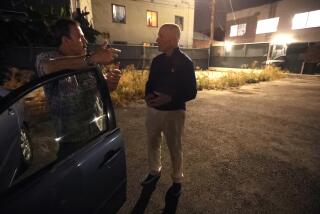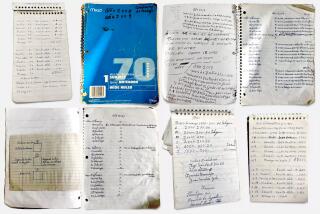Review: What is it like to live on â$2.00 a Dayâ? New book examines deep poverty in the U.S.
For âPromises I Can Keep: Why Poor Women Put Motherhood Before Marriage,â Kathryn J. Edin, with coauthor Maria Kefalas, immersed herself in the lives of Philadelphia-area unwed mothers, exploding myths about their choices. She found that many of these women sought children as a source of love and meaning while disdaining marriage to men unable to provide economic stability.
In her latest book, â$2.00 a Day,â she applies the same analytical skills to a harrowing examination of deep poverty in the United States. This time, Edin, professor of sociology and public health at Johns Hopkins University, teams with H. Luke Shaefer, associate professor at the University of Michigan School of Social Work, to report on both historically destitute regions and those suffering more recent economic decline.
Their research, backed by income data, takes them into the homes of severely cash-deprived families in Chicago, Cleveland, the Mississippi Delta and Johnson City, Tenn. We meet a mother bouncing with her daughter from one homeless shelter to the next, desperate for a minimum-wage job; chronically hungry children who live in cramped, fetid houses often lacking heat, electricity or running water; a woman who sells her blood plasma twice a week to pay the bills; and a 10th-grader who opts to trade sex with a gym teacher for food.
They are the soul of this important and heart-rending book, in the tradition of Michael Harringtonâs âThe Other Americaâ and Alex Kotlowitzâs âThere Are No Children Here.â Their skillfully told stories are meant both to inspire empathy and change policy.
Even after the ebbing of the Great Recession, Edin and Shaefer discover that households subsisting virtually without cash income are disconcertingly easy to find. Writing with clear-eyed compassion for these men, women and especially children at societyâs margins, they emphasize the extent to which the adults embrace the prototypical American values of hard work and individual responsibility. There is, of course, considerable tragic irony in their subjectsâ adherence to American ideals: The labor market and political system have both failed them, and even their distinctly modest versions of the American Dream remain out of reach.
These $2-a-day poor have âhad their share of bad luck; theyâve made their share of bad moves; they have other personal liabilitiesâŚ; and their kin pull them down as often as they lift them up,â the authors write. âYet,â they add, âjobs in the low-wage labor market can be exceedingly unforgiving,â offering no benefits, irregular schedules, limited hours and little security.
The bookâs essential argument is that, in a recession-plagued, post-industrial economy, even low-skill, low-wage jobs can be hard to find and even harder to keep. As a result, policies aimed at ending welfare dependence and helping the working poor, though effective on their face, have been disastrous for many.
While those with consistent work histories have benefited from the expansion of the Earned Income Tax Credit and other programs, the less fortunate have fallen through the proverbial safety net. Instead, they turn to everything from selling sex and food stamps to running off-the-books businesses to eke out survival.
For Edin and Shaefer, the original sin that precipitated the current crisis was the end of what President Clinton called âwelfare as we know it.â That politically potent rallying cry led to the elimination in 1996 of a program aimed largely at nonworking single mothers, Aid to Families with Dependent Children, or AFDC. Together with food stamps, Medicaid and subsidized housing, it made subsistence possible. But for some, it also transformed low-wage labor, which entailed child care and other expenses and led to curtailed benefits, into a bad economic choice. The âreformâ that replaced it made welfare payments temporary and imposed lifetime limits and work requirements. In the process, it flooded the low-wage labor market and gave employers the whip hand.
Edin and Shaefer donât want a return to the past â but rather major public works programs, a higher minimum wage and other marketplace fixes. But history and analysis aside, what will likely remain with readers of â$2.00 a Dayâ are its indelible pseudonymous portraits of families struggling to survive.
It will be hard to forget Jennifer Hernandez, an asthmatic who excels at her janitorial job until she is forced to clean Chicagoâs cold and moldy foreclosed houses, sickens from the dank air and gets her hours drastically reduced. Or Clevelandâs Rae McCormick, an ace cashier who is fired after her housemates use all her gas and she is unable to drive to work. Or the Deltaâs Tabitha Hicks, who tries to protect her mother from a violent thug who beats her bloody â and is evicted when her mother chooses the thug over her.
Finally, there is college-educated Paul Heckewelder, once a middle-class businessman who owned a chain of pizza parlors that employed many family members. A casualty of the recession, he ends up losing it all and sheltering 22 people in a small house without running water. All are trying to live on his single disability check and the proceeds of his scrap metal recycling.
The diabetic Heckewelder and his hard-luck brood serve as a reminder that economic crisis and need can hit almost anyone, and that these families are not âotherâ â they are potentially us.
Klein is a cultural reporter and critic and a contributing editor at Columbia Journalism Review.â
::
$2.00 a Day: Living on Almost Nothing in America
Kathryn J. Edin & H. Luke Shaefer
Houghton Mifflin Harcourt: 240 pp., $28
ALSO
NBA legend Kareem Abdul-Jabbar wrote a novel about Sherlock Holmesâ brother (and itâs good!)
Street kids, poverty and fortitude: Photographer Mary Ellen Markâs stirring last project
L.A. County adds $50 million to funds for fighting homelessness
More to Read
Sign up for our Book Club newsletter
Get the latest news, events and more from the Los Angeles Times Book Club, and help us get L.A. reading and talking.
You may occasionally receive promotional content from the Los Angeles Times.






